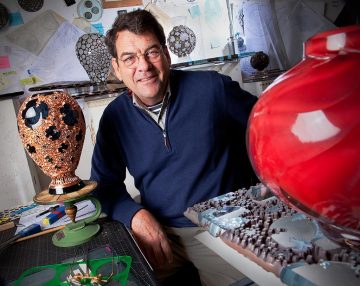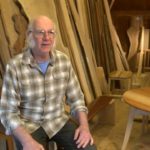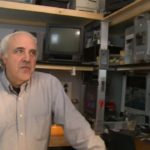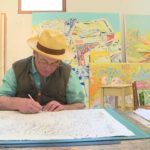
NetWorks Rhode Island and the Chazan Collection Exhibition, WaterFire Arts Center (2024) Bio:
Michael McCoy Glancy, Sr. (1950 – 2020) was born in Detroit, Michigan, and later earned a BFA from the University of Denver in 1973 and a BFA in sculpture from the Rhode Island School of Design (RISD) in 1977. Enticed by the “smoke and fire” of glassblowing, Glancy continued his education with glass artist Dale Chihuly, earning an MFA in glass from RISD in 1980. In 1982, while teaching at Chihuly’s Pilchuck Glass School, he discovered sandblasting and cold-working techniques. He adopted the thick, heavy glass construction of the Italian sommerso and Scandinavian graal, better suited for deep reliefs (in contrast to the Venetian method of blowing paper-thin vessels). Glancy rarely created stand-alone objects, preferring instead to create dynamic pairings of sculpted objects and the complementary bases on which they were placed. The object and its display platform were thus conceived as forming an aesthetic whole. His signature technique was an electroforming process that creates a thin layer of metal on the glass. The artist (or his assistant) stencil-painted his creations with electrically conductive paint, attached electrodes to the object, and placed the object in a chemical bath of metallic compounds. Introducing an electrical current to the chemical bath transferred the metal plating to the painted surface of the glass, producing a clean and defined separation between the two mediums and resulting in the intricately layered texture of each piece. Glancy adopted the Murano model of collaboration between master glass artists and glassblowers first brought to the U.S. by Dale Chihuly. In his own studio in Rehoboth, Massachusetts, he worked predominantly with two assistants, Myles Baer and Adrianne Evans. Baer, who had been with Glancy since the age of sixteen, specialized in cold-working glass techniques such as cutting, grinding, engraving, and sandblasting. Evans developed the lost-wax molds used to cast pate de verre glass and later bronze and stainless steel all metal objects. He collaborated with other glass artists as well. His association with the Pilchuck Glass School introduced him to influential European glass masters and led to a long and fruitful partnership with Swedish glass artist and master glassblower, Jan-Erik Ritzman of Transjo Sweden, with whom he forged a multi-decade collaboration. Glancy was an Adjunct Faculty Member and Senior Critic at RISD in the Jewelry & Metalsmithing department where he taught electroforming from 1982 until his death, and was a multi-session invited faculty member at Pilchuck. A National Endowment for the Arts Award Recipient, his work has been exhibited and collected around the world and is included in many prominent museum collections nationally and internationally.
Original NetWorks Catalogue Bio:
Extraordinary and elegant in quality and beauty, Michael Glancy’s sculptures reveal the artist’s exacting struggle towards perfection. Drawing inspiration from natural macro- and micro-environments, Glancy translates cellular landscapes into elegant jewel-toned sculptural objects. Made with blown and plate glass, copper, bronze, silver, and gold, his works reference science, biology, molecular physics, and mathematics. A native of Detroit, Glancy received a BFA from the University of Denver, a second BFA in sculpture, and an MFA in glass from the Rhode Island School of Design, where he studied with Dale Chihuly. He is a member of the adjunct faculty in the Jewelry and Metalsmithing Department at RISD and has taught at Pilchuck Glass School in Washington. Glancy’s career has included exhibitions in New York City and Switzerland and his work is in major museums and collections.
Source: NetWorks 2013 – 2014 Catalogue

Polished cast stainless steel, industrial plate glass, copper, 10 x 17 x 22 in
Credits:
Video: Richard Goulis
Jan-Erik Ritzman Footage From: Glass, a Dwelling For Light, A Film by Sten Holmberg
Still Photography: Mark Johnston and Marty Doyle
Executive Producer: Joseph A. Chazan, M.D.
Additional Resources:
Artist’s website: michaelglancyglassworks.com
Highlighting the work of selected artists who have played vital roles in shaping the contemporary visual arts community in Rhode Island. This collection of brief video portraits provides a window into the lives, practices, and cultural contributions of professional artists.



